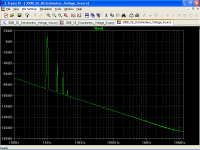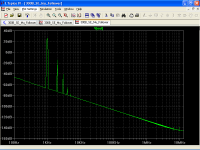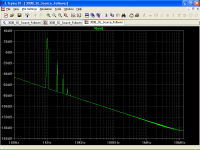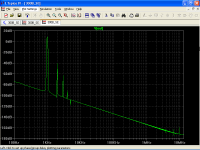There is no cancellation! Cancellation is that of a PP or (the less ideal) two cascaded stages of the SAME type.
Distortion cancellation is useful regardless if interstage transformers are used or not, maybe a couple of simulations would help to see. All simulations are for 1W RMS output.
For a 300B and a distortionless voltage source as input
H2=-35.105dB H3=-55.89dB H4=-88.1dB H5=-105.51dB
At the mu follower output
H2=-13.699dB H3=-40.58dB H4=-64.91dB H5= -77.87dB
As expected, the source follower has very low distortion, so cancellation is very small
H2=-13.71dB H3=-40.62dB H4=-64.94dB H5=-77.88dB
At the output of the amplifier, cancellation is not to uncork champagne, but it is evident
H2=-40.23dB H3=-63.26dB H4=-91.06dB H5=-117.66dB
Attachments
The fundamental on first and last sims is at about 8.98dB, in second and thirth at about 26.59dB, then
1) H2=-44.085dB H3=-64.87dB H4=-97.08dB H5=-114.49dB
2) H2=-40.289dB H3=-67.17dB H4=-91.5dB H5= -104.46dB
3) H2=-40.3dB H3=-67.21dB H4=-91.53dB H5=-104.47dB
4) H2=-49.21dB H3=-72.24dB H4=-100.04dB H5=-126.64dB
Cancellation is still evident.
1) H2=-44.085dB H3=-64.87dB H4=-97.08dB H5=-114.49dB
2) H2=-40.289dB H3=-67.17dB H4=-91.5dB H5= -104.46dB
3) H2=-40.3dB H3=-67.21dB H4=-91.53dB H5=-104.47dB
4) H2=-49.21dB H3=-72.24dB H4=-100.04dB H5=-126.64dB
Cancellation is still evident.
Some back ground reading here that may help enlighten you as to why interstate transformers are worth considering Nutshell High FidelityI think it's a good general representation. Only a fool would pay 400+ dollars for an IT when a great tube based circuit would cost about 50 IMHO.
Also I should mention that I was running open loop.
Attached is a very, very nice little spud amp using 6C45P's that I built on a Leak Stereo 20 Chassis in about 2003. Still using it in fact. Variations along the way have included using Blumlein garters to help balance current through the tubes. Can be built successfully and sound nice with cheapy Edcor input trannies, but became much better with a Sowter input transformer. The geometric balance of the input tranny is an important factor in overall performance.
For a multistage amp, Lundahl 1660 or 1692 (depending on the tube doing the driving) have outstanding performance and are terrific value.
Attachments
Some back ground reading here that may help enlighten you as to why interstate transformers are worth considering Nutshell High Fidelity
The only measurements that I could see are those from "The Sound of the Machine - The Hidden Harmonics behind THD" and they show that interstage transformers produce higher odd-order harmonics, and I do not like this.
Distortion cancellation is useful regardless if interstage transformers are used or not, maybe a couple of simulations would help to see. All simulations are for 1W RMS output.
You don't need to tell, I have used it in many of my economical amps. Do be fooled though it is NOT a substitute for linearity. Sinusoidal (stationary) regime is not exhaustive....
In that case you cite it seems that the transformer has the edge! However, in general I would tend to agree on this for the simple reason that most of those transformers have pretty limited bandwidth. Lundahl and O' Netics are not famous for their wide bandwidth, typically limited to 30-40KHz at best. Not good if one has to have three or even four one after the other....! The Lundahls are good at low frequency if used properly, IME. The only Lundahl interstage I have found with better bandwidth is the older LL-1635 that can do 60-70 KHz in the right conditions.The only measurements that I could see are those from "The Sound of the Machine - The Hidden Harmonics behind THD" and they show that interstage transformers produce higher odd-order harmonics, and I do not like this.
Last edited:
However, in general I would tend to agree on this for the simple reason that most of those transformers have pretty limited bandwidth.
That is good, we have not agreed on something for a long time...
Besides of horrendous prices, good interstage transformers are in the ballpark of 100KHz, right? In my design, at the grid of the 300B, is expected a bandwidth of about 800KHz, for about U$S 20.- per monoblock... JJ300B are way more expensives, but even cheaper than a good IT.
The use/abuse of transformers and gas valves are beyond my little understanding. Am I prejudiced? Yes I am.
Last edited:
In summary, interstage coupling has some advantages:
-Can provide grid current without blocking distortion, especially nice for power stages into A2.
-Can provide step-up or step-down ratios. Great for low mu tubes as mentioned before, or heavy power stage driving.
-When carefully designed, negligible distortion IMHO. Especially for an 1:1 ratio, it is not hard to design an IT with a surplus of flux density and inductance and bandwidths such as 3Hz to 300kHz are more than realistic.
Disadvantages:
-Bulky and heavy
-Expensive
-Can be prone to picking EMF if shielding and design measures aren't taken into account.
-Can provide grid current without blocking distortion, especially nice for power stages into A2.
-Can provide step-up or step-down ratios. Great for low mu tubes as mentioned before, or heavy power stage driving.
-When carefully designed, negligible distortion IMHO. Especially for an 1:1 ratio, it is not hard to design an IT with a surplus of flux density and inductance and bandwidths such as 3Hz to 300kHz are more than realistic.
Disadvantages:
-Bulky and heavy
-Expensive
-Can be prone to picking EMF if shielding and design measures aren't taken into account.
But that's happening because you refuse to accept the reality.That is good, we have not agreed on something for a long time...
No, the good interstage transformers have an upper limit that goes from 200KHz to 1 MHz depending on the model and source impedance one uses.Besides of horrendous prices, good interstage transformers are in the ballpark of 100KHz, right?
It is expected.....and again, cost is subjective and cancellation is not a substitute for linearity. Run the IMD for real, as I said before, and will see.In my design, at the grid of the 300B, is expected a bandwidth of about 800KHz, for about U$S 20.- per monoblock... JJ300B are way more expensives, but even cheaper than a good IT.
The use/abuse of transformers and gas valves are beyond my little understanding. Am I prejudiced? Yes I am.
I agree on the abuse. About the use it looks like you have a prejudice.
Last edited:
In summary, interstage coupling has some advantages:
-Can provide grid current without blocking distortion, especially nice for power stages into A2.
-Can provide step-up or step-down ratios. Great for low mu tubes as mentioned before, or heavy power stage driving.
-When carefully designed, negligible distortion IMHO. Especially for an 1:1 ratio, it is not hard to design an IT with a surplus of flux density and inductance and bandwidths such as 3Hz to 300kHz are more than realistic.
Disadvantages:
-Bulky and heavy
-Expensive
-Can be prone to picking EMF if shielding and design measures aren't taken into account.
50AE, I made that transformer. Still sitting somewhere....shipping it anywhere in Europe is more expensive than the transformer itself!
Disadvantages:
-Bulky and heavy
-Expensive
-Can be prone to picking EMF if shielding and design measures aren't taken into account.
Maybe you must add more odd-order harmonic distortion?
But that's happening because you refuse to accept the reality.See below...
It was not me who deny distortion cancellation since post#52...
No, the good interstage transformers have an upper limit that goes from 200KHz to 1 MHz depending on the model and source impedance one uses.
It was you who put the link
http://www.monolithmagnetics.com/sites/default/files/datasheets/Interstage-transformers/datasheet%20IT-03%2025%20interstage%20transformer%20prelim%20rev%2001.pdf
The plot does not look so impressive to me. Maybe you have some better ones for different source impedance and/or loads?
Last edited:
You are confused about distortion cancellation. Actuyally I don't think you have ever read an article and theory behind it. A common cathode + follower both loaded with CCS are not cancelling H3. One can minimise distortion by tuning the load but it is not cancellation. One cannot use personal definitions (not just you) otherwise it becomes impossible.It was not me who deny distortion cancellation since post#52...
It was you who put the link
http://www.monolithmagnetics.com/sites/default/files/datasheets/Interstage-transformers/datasheet%20IT-03%2025%20interstage%20transformer%20prelim%20rev%2001.pdf
The plot does not look so impressive to me. Maybe you have some better ones for different source impedance and/or loads?
In fact it has 230KHz bandwidth. So?
Unfortunately you picked the model with the worst frequency response. That transformer is for amps were 375V supply have to be exceeded and so cannot use bifilar windings. Come back with a real amp and let's see if you can reach 230KHz. That's an easy target only in simulations....
Last edited:
Maybe you must add more odd-order harmonic distortion?
Odd for little to none DC flux, while dominantly even for high DC flux transformers, such as in SE operations?
Odd for little to none DC flux, while dominantly even for high DC flux transformers, such as in SE operations?
Hi grade steel has low distortion in comparison to the rest. THD, basically H3 and very little H5, only raises to very acceptable entity below 30Hz where there is basically nothing at music level in most cases. IMD caused by that is even smaller as shown before. Properly designed transformers will reach that point around clipping where most of the distortion will come from somewhere else....
If then one really wants to make core distortion negligible just uses 49%Nickel. For PP this is a good choice: very low distortion, low losses, high initial relative permeability at 10000, 1.6T saturation. It comes in handy EI shapes but doesn't have the issue of GOSS EI's because the steel balance in it is non-oriented. Game over.
You are confused about distortion cancellation. Actuyally I don't think you have ever read an article and theory behind it. A common cathode + follower both loaded with CCS are not cancelling H3. One can minimise distortion by tuning the load but it is not cancellation. One cannot use personal definitions (not just you) otherwise it becomes impossible.
Actually you have not answer the question: how can you cancel both even and odd functions with two stages? Still waiting....
You did not understand anything! Please, read again post#81 and post#82
Odd for little to none DC flux, while dominantly even for high DC flux transformers, such as in SE operations?
It has nothing to do with DC flux but with a nonlinear anisotropic magnetic material, SE transformers are more linear than PP due to the air gap, anyway transformers add odd-order harmonics and it is measurable.
My rule of dumb is to use transformers/inductors as little as possible, i.e. PTs and OPTs, less is more... and cheaper!!!
Last edited:
- Status
- This old topic is closed. If you want to reopen this topic, contact a moderator using the "Report Post" button.
- Home
- Amplifiers
- Tubes / Valves
- Theoretical question about interstage transformers



